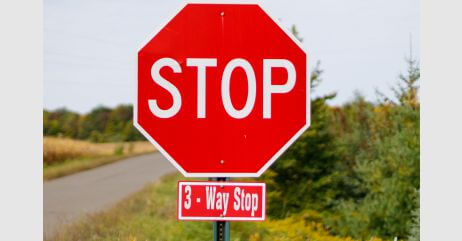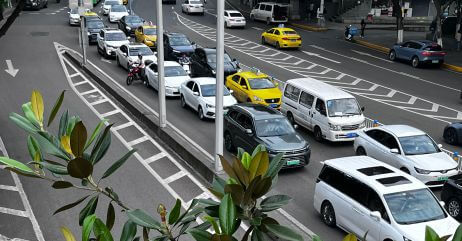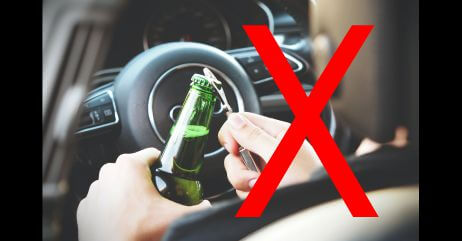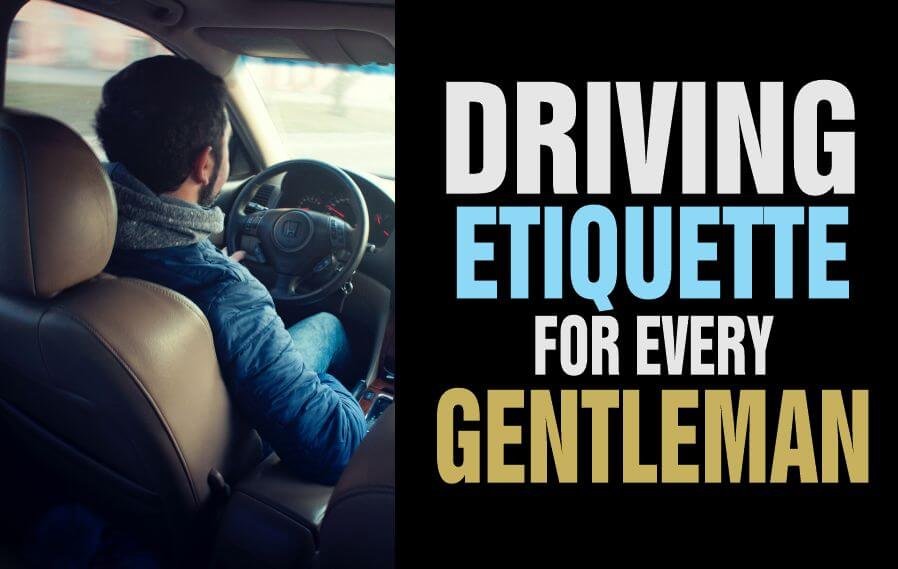Driving etiquette is essential for every gentleman behind the wheel to promote the driving culture for everyone’s safety.
It not only ensures a safer and smoother experience on the road but also reflects your manners and respect towards fellow motorists.
Becoming a bad driver has its roots in the same drive that makes people not observe internet etiquette.
Some men assume another personality when they click the seat belt and hit the road.
They feel immortal and demand worship from other road users, which always brings about the road rages and other uncomplimentary road behaviours you see.
Adopting a gentlemanly attitude behind the wheel can contribute to a positive and harmonious driving culture.
Whether it’s signaling before changing lanes, yielding to pedestrians, or maintaining a safe distance, there are several rules and practices that define good driving etiquette.
In this article, we will explore the key principles of being a gentleman on the road, emphasizing the importance of courtesy, patience, and respect for others.
Table of Contents
- The Mindset of a Gentleman Behind the Wheel
- How Does Road Rage Affect Your Driving Skills and Judgement
- Driving Etiquette and The Rules of the Road
- Communication on the Road
- Managing Traffic and Congestion
- Parking Etiquette
- Dealing with Challenging Situations
- Using Technology Responsibly
- Sharing the Road with Public Transportation
- Being a Role Model for Young Passengers
- Road Rage and Conflict Resolution
- How Does Road Rage Affect Driving Skills And Judgement?
- The Impact of Being a Gentleman on the Wheels
- Conclusion
The Mindset of a Gentleman Behind the Wheel
The mindset of a gentleman behind the wheel should be a courteous one, hinging on respect for the driving culture.
Driving for some people has become a chore, and it’s best to make this chore at least a little pleasant to make the road safe for everyone.
The gentleman behind the wheel should prioritize safety, patience, and decorum on the road while considering the other road users – other drivers, pedestrians, and cyclists.
Here are the factors that should constitute the mindset of a gentleman behind the wheel:
1. Patience and Calmness in Traffic Situations
As a gentleman behind the wheel, you should understand the frustrations that can arise in traffic situations but chooses to remain patient and calm.
This is because, most times there is nothing you can do about it apart from being patient.
Instead of letting the stress and impatience get the better of you, you should maintain self-control and take a rational approach to navigating through traffic.
This allows you to make better decisions, avoid aggressive behavior, and minimize the chances of accidents.
Also Read: Gentleman’s Guide to Online Civility
2. Avoiding Aggressive Behaviour and Road Rage
As a gentleman behind the wheel, you should consciously avoid engaging in aggressive behavior on the road, such as tailgating, honking excessively, or forcefully changing lanes.
You should understand that reacting angrily or aggressively not only puts yourself and others at risk but also creates a hostile driving environment.
Everybody can get mad including the gentleman, but you should make it justifiable and aggression behind the wheel is not one way to do so.
Keeping your emotions in check and avoiding road rage, not only contribute to a safer and more pleasant driving experience for everyone but also saves you from bad blood pressure.
3. Respecting Other Drivers, Pedestrians, and Cyclists
Almost all the time, there seems to be a competition between drivers as to who outdo each other in cursing and yelling.
Whether it’s a form of fun or it’s actual bitterness, it does not one any good. Sticking out your neck from the window to curse out at someone who blocked you or slowed your movement is ungentlemanly.
A gentleman behind the wheel displays respect and consideration toward other road users.
Related: Gentleman’s Guide to Table Manners and Etiquette
You might follow traffic rules and regulations, give right of way when appropriate, and practice defensive driving techniques to anticipate and respond to the actions of others, but this does not guarantee you curses from uncouth road users.
Sometimes, all you can do is just ignore.
The gentleman on the wheel also gives space to pedestrians and cyclists, ensuring their safety by allowing them to cross or navigate the road unhindered.
It baffles me most time when I see motorists intimidating pedestrians and cyclists because they see them as less road users.
This is most inhuman, ignorant, and unbecoming of a gentleman.
When you acknowledge and respect the rights of others, a gentleman behind the wheel promotes a harmonious and cooperative atmosphere on the road.
In all, the mindset of a gentleman behind the wheel observes qualities such as patience, calmness, respect, and consideration.
Related: Taking Chivalry to the Internet
How Does Road Rage Affect Your Driving Skills and Judgement
Road rage is like having a bully in the driver’s seat. It severely impacts driving skills and clouds your judgement, you become distracted, aggressive, making you miss important things on the road.
Your focus narrows on the frustrating driver, like tunnel vision, and you might not see a sudden stop or car changing lanes.
This anger also leads to risky decisions like speeding or swerving, turning a minor annoyance into a major accident.
These behaviors increase the risk of accidents and put not only you, the enraged driver but also other motorists and pedestrians in danger.
Driving Etiquette and The Rules of the Road

Of course, the road has rules that keep everybody safe when adhered to. These rules are already established in the laws of the land.
Rules of the road are established traffic laws that guide how vehicles should operate on public roadways to ensure safety and order.
These rules help to keep ungentlemanly drivers in check for a harmonious and predictable environment for all road users, including motorists, pedestrians, and cyclists.
Here are ways to achieve that:
Adhering to Traffic Laws and Regulations
Adhering to traffic laws and regulations means obeying all rules set by authorities to govern road usage.
This includes following speed limits, traffic signals, road signs, and seat belt laws.
Complying with these laws promotes safety, reduces accidents, and contributes to a well-organized and harmonious road environment.
Here is how you can achieve that:
- Traffic signals and signs: You should observe driving etiquette by obeying traffic signals as a gentleman on the wheel, such as stoplights and stop signs, as well as road signs indicating speed limits, no-entry zones, yield signs, and more.
- Speed limits: Don’t be tempted to exceed the speed limit because you got a fast ca. You must adhere to posted speed limits and adjust your speed based on road conditions, traffic, and weather.
- Seat belts and child restraints: This does not need any flogging. Wearing seat belts is mandatory for all occupants in the vehicle, and children must be properly secured in appropriate child safety seats.
Related: Guides to Handshaking Etiquette
- Alcohol and drugs: Driving under the influence of alcohol or drugs is strictly prohibited and subject to severe penalties.
- Cell phone usage: Many jurisdictions have laws against using handheld devices while driving to minimize distractions.
- Lane discipline: Stay in your lane and use indicators when changing lanes or making turns.
- Overtaking and passing: Follow proper procedures when overtaking slower vehicles, ensuring it is safe and legal to do so.
- Parking regulations: Vehicles must be parked legally and not obstruct traffic or emergency services.
Understanding Right-of-way and Yielding Rules

Right-of-way and yielding rules dictate which vehicle or pedestrian has priority at intersections or crosswalks.
You must observe driving etiquette by yielding to others already in the intersection or obeying yield signs.
Giving way appropriately prevents collisions, ensures smooth traffic flow, and promotes safety for all road users.
Here is how to achieve those:
Intersections: You must yield to vehicles already within the intersection and follow right-of-way rules for various types of intersections (e.g., four-way stops, roundabouts).
- Pedestrians: Pedestrians usually have the right-of-way at crosswalks, and drivers must stop to let them cross safely.
- Emergency vehicles: In the event that you run into emergency vehicles with their lights and sirens activated, providing them a clear path to proceed is in excessively good taste.
- School zones and buses: As a gentleman behind the wheel, you must yield to school buses when their stop signs are extended and be cautious in school zones.
- Yield signs: It is a good driving etiquette to yield to other vehicles as indicated by yield signs, allowing them to proceed before entering traffic.
Related: Gentleman’s Guide to Chatting
Practicing Defensive Driving Techniques
My dad used to say that as a gentleman behind the wheel who observes driving etiquette, I should drive for myself and the other driver.
He went ahead to say I should see the next driver as mentally unstable.
Defensive driving is a proactive approach to road safety, focusing on anticipating and avoiding potential hazards and accidents.
When you drive defensively, you stay alert, maintain a safe following distance, obey traffic laws, and be mindful of other drivers’ actions.
The goal is to reduce risks and promote safe driving habits.
Here are ways to achieve that:
- Awareness: Being attentive and aware of the surroundings, anticipating potential hazards, and keeping an eye on the actions of other road users.
- Following distance: Maintaining a safe following distance behind the vehicle in front to allow ample reaction time in case of sudden stops or emergencies.
- Avoiding distractions: Minimizing distractions like using phones, eating, or adjusting the radio to stay focused on driving.
- Adapting to weather conditions: Adjusting driving speed and behavior during adverse weather conditions like rain, snow, or fog.
- Handling road rage: Staying calm and composed in challenging situations, avoiding aggressive behavior, and not retaliating to aggressive drivers.
- Scanning ahead: Keeping an eye on the road further ahead to identify potential risks and hazards.
- Being visible: Ensuring your vehicle’s lights are working correctly and using indicators to communicate intentions to other drivers.
- Understanding vehicle capabilities: Knowing the limits of your vehicle, such as braking distance, and adjusting driving accordingly.
Related: Gentleman’s Personal Space Etiquette
Communication on the Road
Yes! Drivers communicate effectively without talking. Communication on the road is an important skill of being a gentleman behind the wheel, as it helps promote safety and understanding among all road users.
Clear and courteous communication ensures predictability and reduces the likelihood of accidents and misunderstandings.
Here are tips to achieve that:
Proper Use of Turn Signals
Using turn signals is essential to indicate your intentions to other drivers.
Signal well in advance of turning or changing lanes to give others time to react appropriately.
This promotes safer lane changes, turns, and merges, and it shows consideration for fellow drivers.
Hand Gestures and their Impact on Other Drivers
Hand gestures can convey emotions and intentions while driving.
As a gentleman behind the wheel, avoid using aggressive or offensive gestures, as they can escalate tensions and lead to road rage.
Instead, use positive gestures, like a wave or a thumbs-up, to express appreciation and courtesy.
Utilizing the Horn Judiciously
The horn is an essential communication tool but should be used with caution.
As a gentleman behind the wheel, use the horn sparingly and only when necessary, such as alerting others to potential dangers or avoiding collisions.
Avoid honking out of frustration, as it can create a hostile driving environment.
Practicing effective communication on the road, a gentleman behind the wheel enhances a more harmonious driving environment, reduces stress and conflicts, and contributes to a safer and respectful road culture.
Related: How to Be a Gentleman on Social Media
Managing Traffic and Congestion

You might run into congestion hoping it will fizzle in a minute, and before you say jack, other vehicles are behind you and you are stuck in an uncertain gridlock.
This could be a frustrating situation especially when you have an important task to catch.
As a gentleman behind the wheel still, managing traffic and congestion involves navigating the roads with courtesy and consideration for other drivers.
Sometimes there is nothing you can do apart from coming down and see how to organize other drivers to free the gridlock if there no road safety officers around.
Other times, you just have to do the waiting game.
Let’s examine some ways to avoid such situations:
Merging Lanes with Grace and Cooperation
When approaching a merge point, a gentleman behind the wheel understands the importance of properly merging with other vehicles.
They anticipate the merge in advance, signaling their intention to change lanes early, and allowing adequate space for other drivers to merge smoothly.
They aim to create a cooperative atmosphere by allowing one vehicle at a time to merge in a zipper-like fashion, promoting a sense of fairness and preserving the flow of traffic.
Creating Space for Other Drivers to Merge
A gentleman behind the wheel understands that merging can be challenging for other drivers, especially in heavy traffic.
They proactively create space by adjusting their speed or position on the road to accommodate merging vehicles.
This may involve briefly slowing down or changing lanes themselves to provide a gap for merging drivers, thus facilitating a seamless merge and preventing unnecessary bottlenecks.
Related: Walking Etiquette for the Gentleman
Avoiding Aggressive Lane-cutting and Tailgating
One of the key principles of being a gentleman behind the wheel is to avoid aggressive behavior that can exacerbate traffic congestion.
This includes refraining from lane-cutting, which is abruptly changing lanes to skip ahead in traffic, causing disruptions and potential accidents.
Instead, a gentleman behind the wheel patiently waits for their turn to progress and doesn’t engage in risky maneuvers that can create further congestion.
Additionally, they maintain a safe following distance by avoiding tailgating, thereby reducing the chances of collisions and contributing to a smoother flow of traffic.
Parking Etiquette

I remember when I learned how to drive, parking was the most difficult for me.
To be honest, there are some moods I will be in and I would park like a learner.
Most people feel the same and cannot just get better with parking.
Parking etiquette is following a set of rules and guidelines while parking, in order to maintain order and ensure convenience for all drivers.
It involves considerations like parking within designated spots, leaving ample space between vehicles, and assisting others in finding parking spaces.
Let’s take a good look…
Parking Within Designated Spots and Following Parking Signs
There are always signs and parking instructions in every parking lot, and a gentleman behind the wheel would not violate this.
Here are some tips:
Stay within the parking lines: When parking, it is important to position your vehicle entirely within the designated parking spot. This helps maximize the available parking spaces for others.
Observe parking restrictions: Pay attention to parking signs and markings on the ground to ensure you are parking in areas allowed by the rules. This may include time limits, zones reserved for specific permits, loading-only areas, or no parking zones.
Leaving Ample Space Between Vehicles
Not every driver knows that parking a car means not just inserting the car within a space that just fits the car, there should be room for both doors to be opened without touching the next car or object.
Here are some tips:
Avoid crowding neighboring vehicles: While parking, make sure to leave enough space between your vehicle and the ones on either side. This ensures that other drivers can comfortably enter or exit their vehicles.
Park straight: Take care to align your vehicle properly within the parking spot to maximize space utilization and avoid encroaching on neighboring spots.
Also Read: Origin of Chivalry and Examples
Assisting Others in Finding Parking Spaces if Possible
There are times when we are in the position to assist others around the parking lot.
As I mentioned above, not many drivers can park a car comfortably, especially understanding the size of their car and how they can fit in into a parking space.
You can always assist by giving directives and watching for them. Remember, one of the many qualities of a gentleman is to make situations easier for people.
Here are some tips:
Communicate about available spots: If you are leaving a parking spot and notice someone looking for a space, you can give them a heads up, allowing them to benefit from the soon-to-be-vacant spot.
Avoid taking up multiple spots: Park in a single spot whenever possible, even if you have a larger vehicle. This leaves more space available for others and avoids frustration.
Residential Street Parking Etiquette
Residential street parking etiquette involves respecting the needs and rights of both residents and visitors.
When parking on a residential street, always park parallel to the curb, leaving enough space for other vehicles to pass safely.
Avoid blocking driveways, fire hydrants, and mailboxes, as this can inconvenience residents and create safety hazards. If there are designated parking zones, use them appropriately.
Be mindful of the posted parking regulations and time limits, ensuring you don’t overstay your welcome.
Maintain a reasonable distance from neighboring vehicles to prevent dings and scratches. During snowfall, follow snow emergency rules to facilitate plowing and maintain traffic flow.
Keep noise levels down, especially during late hours, to be considerate to the neighborhood’s peacefulness.
Ultimately, residential street parking etiquette centers on being considerate, obeying local parking rules, and fostering a harmonious environment for residents and visitors alike.
Related: Gentleman’s Guide to Elegant Dressing
Motorcycle Parking Etiquette
Motorcycle parking etiquette involves parking responsibly and courteously. Park only in designated motorcycle parking areas whenever possible, leaving room for other bikes.
Avoid blocking pedestrian walkways, entrances, or obstructing cars in regular parking spaces.
Use the provided motorcycle stands if available. Never park in spots reserved for disabled individuals or in no-parking zones.
Keep noise levels down and avoid revving the engine excessively, especially in residential areas. Be mindful of others when maneuvering your bike in tight spaces.
Respecting these guidelines ensures a safer and more considerate environment for all road users.
Dealing with Challenging Situations
Dealing with challenging situations while driving is an essential driving etiquette to ensure the safety of yourself and others on the road.
You should endeavour to observe the driving etiquette of remaining calm as a gentleman behind the wheel.
Make informed decisions, and respond appropriately to unexpected roadblocks, emergency vehicles, and other drivers’ mistakes.
Handling Unexpected Roadblocks or Closures Calmly
Encountering unexpected roadblocks or closures can be frustrating and potentially dangerous.
However, it is important that you remain calm and not let your emotion be hijacked.
Here are steps that could help:
Observe and assess the situation: Pay attention to any signs, signals, or instructions from authorities that inform about roadblocks or closures. Understand the reason behind the disruption to determine the best course of action.
Plan an alternative route: Utilize GPS or traffic apps to find alternate routes around the roadblock or closure. Planning a detour beforehand will help avoid unnecessary delays and frustration.
Adapt to the situation: Be patient and adapt your driving behavior to the changing circumstances. Follow traffic guidelines and road signs to navigate safely and smoothly through unexpected roadblocks.
Yielding to Emergency Vehicles Promptly and Safely
When an emergency vehicle, such as an ambulance, firetruck, or police car, approaches with sirens and flashing lights, you have to yield the right of way.
Here’s how to yield promptly and safely:
Be aware of your surroundings: Continuously scan your surroundings and check your mirrors for approaching emergency vehicles. Keep the volume of your music or other distractions low to hear their sirens or see their flashing lights.
Create a clear path: When an emergency vehicle is approaching, safely and promptly maneuver your vehicle to the side of the road, giving them ample space to pass through. Signal your intention so other drivers are aware of your movements.
Stop if necessary: If you are at an intersection, stop even if you have a green light or right of way. Allow the emergency vehicle to pass before proceeding. If you are already in an intersection, clear it safely before pulling over.
Reacting Courteously to Other Drivers’ Mistakes
Encountering mistakes made by other drivers on the road is common.
Reacting courteously and responsibly helps maintain a safe driving environment.
Here are some suggestions:
Stay calm and patient: If another driver makes a mistake, it’s important not to react aggressively or with road rage. Take a deep breath, remind yourself that everyone makes mistakes, and focus on maintaining your own safe driving behavior.
Give space: If another driver merges into your lane without signaling or cuts you off, maintain a safe following distance and allow them space.
Avoid retaliating or engaging in aggressive maneuvers which can lead to damage and a more uncomfortable situation.
Avoid confrontation: In situations where another driver behaves recklessly or aggressively, it’s essential to prioritize your safety and the safety of others on the road.
Avoid retaliating or confronting the driver directly. Instead, distance yourself by changing lanes or exiting the roadway if necessary.
This might sound cowardly, but you are a gentleman and shouldn’t let people drag you into situations you are not prepared for. I am sure you have had your day plan figured out, and road altercation is not one of them.
Pedestrian and Cyclist Respect
As a gentleman behind the wheel, you should respect pedestrians and cyclists as they are vulnerable road users who have a higher risk of injury or accidents compared to drivers of motorized vehicles.
Respecting and prioritizing their safety not only promotes a more harmonious and considerate road environment but also plays a crucial role in reducing accidents and potential harm to these individuals.
Here are ways to achieve that:
Stopping for Pedestrians at Crosswalks
It breaks my heart when vehicle drivers curse out at pedestrians and cyclists who struggle to cross the road or negotiate an intersection.
These are human beings with high risk on the road, as a gentleman, you should place yourself in their shoes and see you have to give them priorities
Here are ways to go about that:
- Legal obligation: In many jurisdictions, it is legally mandated to stop for pedestrians at crosswalks. Respecting this rule not only helps in compliance with traffic regulations but also ensures the safety and well-being of pedestrians.
- Courtesy and empathy: Stopping for pedestrians at crosswalks displays consideration and empathy for these individuals. It acknowledges their right to safely cross the road and demonstrates a gentleman behind the wheel’s commitment to creating a safer road environment for everyone.
Keeping a Safe Distance from Cyclists
One driving etiquette for cyclists is to be visible on the road. This is to ensure that other road users, especially motorists have a clear view of them.
On the other hand, motorists should also look out for cyclists who might by reckless, keep a reasonable distance from them so you have room for maneuvering in case of any eventuality.
These tips will help:
- Avoiding accidents: Maintaining a safe distance from cyclists is a good driving etiquette to prevent accidents. Cyclists often have limited maneuverability and may need to suddenly change lanes or make turns, thus requiring sufficient space for their movement.
- Protecting vulnerable road users: Cyclists are highly vulnerable to injuries in case of collisions. Respecting their presence and providing ample room helps ensure their safety and avoids potential accidents that may result in severe harm.
Anticipating and Respecting Vulnerable Road Users
It is good driving etiquette to always think ahead of time when driving. Anticipate into the unknown and you will not be taken unawares with any eventuality.
The following will keep you safe in this guise:
- Awareness: A gentleman behind the wheel should be aware of the presence of vulnerable road users, including pedestrians and cyclists. Keeping an eye out for potential crosswalks, bike lanes, or areas with high pedestrian activity helps in anticipating their movements and avoiding any last-minute surprises.
- Patience and caution: Gentlemen drivers should exercise patience while driving near vulnerable road users, as their speed and movement might not be as fast as motorized vehicles. Being cautious and maintaining a safe driving speed helps to avoid any inadvertent harm to these individuals.
- Yielding right of way: Respecting vulnerable road users means yielding the right of way when necessary. It implies allowing pedestrians to cross before making a turn or giving cyclists enough space before merging or overtaking them.
Related: How to Drive the Gentleman’s Way
Using Technology Responsibly
Using technology responsibly as a gentleman behind the wheel means recognizing the importance of minimizing distractions while on the road and prioritizing driving etiquette for the safety of oneself and others.
This involves adhering to certain driving etiquette and avoiding engaging in activities that may divert attention from driving.
Here are some safety measures to consider:
Avoiding Texting and Driving
Texting while driving is extremely dangerous, as it takes attention away from the road and significantly increases the risk of accidents.
As a gentleman behind the wheel, it is crucial to refrain from texting or reading messages while behind the wheel.
Instead, one should pull over to a safe location if it is necessary to respond to a message or use a voice-to-text feature if available.
Using Hands-free Devices for Calls
Making or receiving phone calls while driving can also become a distraction.
However, using hands-free devices such as Bluetooth-enabled earpieces or speakerphone systems allows drivers to have conversations without taking their hands off the wheel.
This way, they can stay focused on the road while still being able to communicate.
Not Engaging in Distracting Activities while Driving
Apart from texting and calls, there are numerous other activities that can divert attention while driving.
As a responsible gentleman behind the wheel, it is important to avoid engaging in these distracting activities.
This includes but is not limited to, browsing the internet, watching videos, using social media, eating, grooming, or reaching for objects within the car.
When you refrain from these distractions, you can maintain your focus and minimize the risk of accidents caused by a loss of attention.

Sharing the Road with Public Transportation
Sharing the road with public transportation is inevitable and sometimes is one of the causes of road rages.
This is where a gentleman behind the wheel needs to observe the driving etiquette of patience and being considerate and cooperative while sharing the road with buses, taxis, cyclists, and other forms of public transportation.
Here are some tips that help:
Allowing Buses and Taxis to Merge and Stop Safely
It is important to give buses and taxis enough space and time to merge safely into traffic or pull over to pick up or drop off passengers.
Drivers should be vigilant and yield to buses and taxis when necessary, ensuring the smooth flow of traffic.
Giving Space to Cyclists Near Bus Stops
There is a need for drivers to be mindful of cyclists, especially when they are near bus stops.
Providing ample space for cyclists to maneuver and ensuring their safety by avoiding sudden maneuvers or actions that may endanger them while they navigate around bus stops is advised.
Being Patient when Public Transportation Causes Delays
There is also a need for drivers to remain patient and understanding when public transportation causes delays.
It encourages drivers to avoid aggressive behavior, such as honking or cutting off buses or taxis, as such behavior may escalate the situation or endanger other road users.
Being patient and considerate helps maintain a safe and harmonious flow of traffic.
Being a Role Model for Young Passengers
When people drive, young passengers observe and will replicate what they see in the future.
Observing good driving etiquette is a good way to passively teach young people how to behave behind the wheel.
This not only ensures a safe driving environment but also instills good habits in children and young drivers who observe their behavior.
Here are tips to observe driving etiquette to teach the young generation:
Setting a Good Example for Children and Young Drivers
Gentlemen drivers should display exemplary driving skills and obey traffic rules consistently.
By doing so, they teach young passengers the importance of responsible driving, such as wearing seat belts, using indicators, following speed limits, and avoiding distractions.
This behavior helps shape the mindset of children and young drivers towards safe and responsible driving practices.
Explaining the Importance of Courteous Driving Behavior
As a role model, a gentleman behind the wheel should communicate to their young passengers the significance of treating other drivers with respect and kindness.
This involves explaining the importance of using proper signaling, allowing others to merge, not tailgating, and refraining from aggressive driving behaviors.
Highlighting the benefits of courteous driving, such as reducing accidents and maintaining a peaceful driving environment, they encourage young passengers to adopt respectful behavior on the road.
Road Rage and Conflict Resolution
Every gentleman behind the wheel must have engaged in one kind of road rage or another, either passively or directly.
As a gentleman behind the wheel, you might not be interested in cursing others, but you could be dragged into it.
Road rage is the aggressive or violent behavior exhibited by drivers in response to traffic or driving-related incidents.
Road rage can include yelling, physical altercations, tailgating, or reckless driving.
However, engaging in road rage is not the only way out of driving-related issues.
Conflict resolution, on the other hand, is the process of finding a peaceful and satisfactory resolution to conflicts or disputes.
These tips will go a long way to help:
Recognizing Signs of Road Rage in Yourself and Others
It is important to be aware of signs of road rage in oneself and others to prevent the situation from escalating further.
Signs may include excessive speeding, honking, aggressive gestures, weaving between lanes, continuous swearing or shouting, or displaying acts of aggression towards other drivers.
Techniques for Diffusing Tense Situations
In order to diffuse tense situations on the road, several techniques can be employed.
These include staying calm and avoiding engaging in aggressive or provocative behavior, giving way to the aggressive driver or allowing them to pass, refraining from making eye contact or responding to aggressive gestures, using non-confrontational body language, and practicing defensive driving techniques.
When to Involve Law Enforcement or Report Aggressive Driving
It is advisable to involve law enforcement or report aggressive driving when the situation escalates beyond one’s control.
This may include instances where a driver is exhibiting extreme aggression or violence, posing a threat to the safety of oneself or others on the road.
Reporting aggressive driving behaviors, such as excessive speeding, racing, or reckless driving, to the appropriate authorities can also help prevent future incidents and ensure safer roads for everyone.
How Does Road Rage Affect Driving Skills And Judgement?
Road rage can significantly impair driving skills and judgment, leading to dangerous situations on the road.
This is why driving etiquette is important to master so this emotional hijack can be averted with its attendant dangers.
When experiencing road rage, you may become highly aggressive, emotional, and impulsive, which can negatively impact your ability to make rational decisions while driving.
Physiologically, road rage triggers your body’s stress response, leading to an increase in adrenaline and cortisol levels.
This heightened state of arousal can result in impaired fine motor skills and reduced ability to focus on the road.
Reaction times may slow down, making it challenging to respond quickly to sudden changes or hazards on the road.
Emotionally, road rage can cloud judgment and escalate risky behaviour.
Agitated drivers may engage in tailgating, excessive speeding, or aggressive lane changes, increasing the likelihood of accidents and collisions.
Impaired judgment can also lead to poor risk assessment and a disregard for traffic laws.
Additionally, road rage can escalate confrontations with other drivers, potentially resulting in physical altercations or aggressive behaviors that further compromise safety.
The Impact of Being a Gentleman on the Wheels
Of course, adhering to road instructions as a driver has many benefits both for the gentleman behind the wheel, road users and society.
Being a gentleman behind the wheel means adopting a courteous and respectful approach towards driving, with an emphasis on promoting safety, promoting positive driving culture, and inspiring others to adopt similar habits.
The impact of being a gentleman behind the wheel can be significant in shaping the behavior and attitudes of drivers in a community, contributing to a safer and more pleasant road environment, and inspiring others to adopt courteous driving habits.
Promoting a Positive Driving Culture in the Community
Being a gentleman behind the wheel helps to foster a positive driving culture in the community by emphasizing the importance of respect, patience, and consideration towards others on the road.
When drivers exhibit courteous behavior, such as allowing others to merge, using turn signals, and refraining from aggressive or reckless driving, it sets a positive example for others.
This creates a ripple effect, encouraging other drivers to adopt similar habits and contributing to an overall improvement in driving culture within the community.
Contributing to a Safer and More Pleasant Road Environment
The impact of being a gentleman behind the wheel also extends to creating a safer and more pleasant road environment.
Prioritizing safety, following traffic rules, and being alert and attentive while driving, gentlemen behind the wheels reduce the risks of accidents and injuries on the road.
They also contribute to a more pleasant road environment by promoting a sense of unity and cooperation among drivers, leading to reduced road rage incidents and a more harmonious driving experience for everyone.
Inspiring Others to Adopt Courteous Driving Habits
When drivers exhibit gentlemanly behavior on the road, it can have a profound impact on others, inspiring them to adopt courteous driving habits.
By consistently demonstrating traits like patience, respect, and kindness towards fellow drivers, pedestrians, and cyclists, gentlemen behind the wheels challenge the prevalent negative stereotypes associated with aggressive driving.
This positive influence encourages others to reflect on their own driving habits and motivates them to make conscious efforts to be more considerate and courteous while driving.
Conclusion
Driving etiquette is not just about following the rules of the road, but also about being considerate, respectful, and responsible while behind the wheel.
Driving etiquette and culture emphasizes the importance of kindness, patience, and courtesy in our daily commutes.
By practicing good driving habits, such as using blinkers, avoiding aggressive behaviors, and yielding to others, we can create a safer and more pleasant driving environment for everyone.
Ultimately, being a gentleman behind the wheel not only benefits us but also promotes a culture of respect and civility on the roads, leading to a more harmonious and enjoyable driving experience for all.
References:
https://www.artofmanliness.com/character/etiquette/car-etiquette/
Pyo Merez is a men’s lifestyle enthusiast and writer about the gentleman’s place and impact on society. Raised by a distinguished gentleman dad, he offers unique insights into how the mind of a gentleman works and how societal norms shape gentlemen’s identity and vice versa.
Through his insightful articles, Pyo taps into the depths of gentleman culture to provide perspectives on etiquette and manners in modern society.

